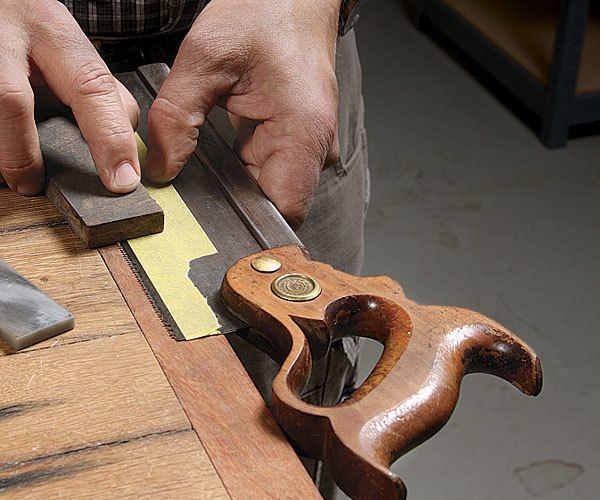Sharpen Your Own Backsaw
If you can sharpen a plane iron, you can sharpen a sawtooth, as professional saw maker Mark Harrell explains.

Synopsis: There’s a lot of complicated detail out there about the best way to sharpen a handsaw, but professional saw maker Mark Harrell says you don’t really need it. You can sharpen any backsaw using a few simple tools and his step-by-step method. Learn how to turn your vise into a saw vise using a few strips of angle iron and some leather. Then learn how to mark and joint the teeth, and file the gullets for the tooth pattern you want, whether it’s rip, crosscut, or a hybrid of the two.
If you can sharpen a plane iron, you can sharpen a sawtooth. There’s a lot of information online about tooth geometry, and it can be valuable for folks like me who sharpen saws every day, some of which are heavily damaged. but that level of detail is overkill for most woodworkers, who simply need to sharpen a Western-style backsaw that is in good shape but dull.
Maybe you have a nice vintage saw, or you purchased a great new model a few years ago and it’s time to freshen up the teeth. In these situations, you can simply replicate the original sharpening angles and make things easy on yourself. but you can use my methods to resharpen almost any backsaw—be it a tenoning or dovetail saw sharpened for rip cutting, a dedicated crosscut saw such as a carcase or miter saw, or an all-purpose saw with a hybrid pattern.
Wondering if your saw is dull? If you have to apply downward pressure to get the saw to cut—in other words, if the weight of the saw is not enough on its own—your saw needs sharpening.
You don’t need many specialized tools to sharpen a saw. You can turn any vise into a saw vise with two pieces of angle iron and two strips of leather. You need to see the small teeth very clearly, and it is easiest to keep your body position (and your filing angle) consistent if you are standing. Therefore, the closer the vise is to your chest height, the easier things will be. This is why I use a machinist’s vise, which stands taller than a woodworking vise (and can be raised with blocks underneath).
You need two files to sharpen a saw: a flat bastard, or single-cut, mill file and a triangular tapered saw file. Choose the smallest saw file that will do the job. Too much file sticking up above the tooth line will make it harder to settle into the gullets and match the angle already there. For safety and control, put handles on your files. Last, you need a couple of Arkansas whetstones, one soft and one hard, used for sharpening knives and sold at hardware stores.
For the full article, download the PDF below.
Fine Woodworking Recommended Products

Wen Diamond Grinding Wheel

Bahco 6-Inch Card Scraper

Veritas Wheel Marking Gauge








Log in or create an account to post a comment.
Sign up Log in